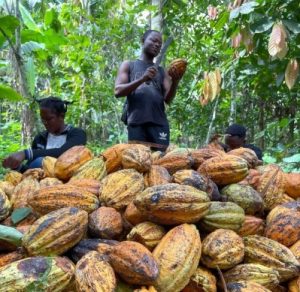Uncertain supply, demand jolt cocoa market as heavy rains threaten production
November 21, 2022449 views0 comments
By Onome Amuge
The cocoa market has been plunged into challenges of uncertain supply and demand following reports of flash floods in top producer Côte d’Ivoire as well as other producing countries in the West and Central Africa regions, the International Cocoa Organisation (ICCO) stated in its latest monthly market report.
Read Also:
 In Côte d’Ivoire, the floods are reported to have restricted the transportation of cocoa beans from the farms to the ports and have been identified as a major reason for the drop in year-on-year cocoa arrivals seen during the first few weeks of the 2022/23 season at the country’s ports of exports.
In Côte d’Ivoire, the floods are reported to have restricted the transportation of cocoa beans from the farms to the ports and have been identified as a major reason for the drop in year-on-year cocoa arrivals seen during the first few weeks of the 2022/23 season at the country’s ports of exports.
As at 06 November 2022, cumulative volumes of arrivals of cocoa beans in Côte d’Ivoire were reported at 348,000 tonnes, down by 23 percent year-on-year compared to 452,000 tonnes recorded during the corresponding period of the previous season.
A reduction in cocoa yields is expected should torrential rainfall persist, as soil nutrients will be washed away. This will further exacerbate the current problem associated with increasing fertilizer prices.
In Ghana, while no fresh data were available on the level of volumes of graded and sealed cocoa beans for the 2022/23 season, the situation is being closely monitored as the country recorded a drastic cut in production compared to last season, due in part to the devastating effect of the Cocoa Swollen Shoot Virus Disease (CSSVD), illegal mining on cocoa farms and reduced use of fertilizer due to the high prices.
According to the ICCO, heavy rains observed in the main cocoa growing areas in West Africa were raising concerns over a potential outbreak of the black pod disease, which could subsequently be detrimental to the volume of the 2022/23 cocoa year main crop and consequently result in higher prices for the commodity.
Despite the recovery in grindings in 2021/22 on the back of the economic recovery from the COVID-19 pandemic, mixed results have been posted by members of the European Cocoa Association (ECA), Cocoa Association of Asia (CAA) and National Confectionery Association (NCA), who held about 56 percent of the world share of grindings in 2021/22.
For the 2021/22 cocoa season, cocoa processing activities increased year-on-year in Europe
and Southeast Asia, but dropped in North America. On a crop year basis, the ECA posted data indicating that cumulative grindings in Europe during 2021/22 increased year-on-year by 2.68 percent from 1,434,631 tonnes to 1,473,084 tonnes, while the CAA published data showing a 4.79 percent increase from 863,239 tonnes to 904,597 tonnes.
However, grindings in North America, including the US, witnessed a year-on-year decline of 3.44 percent from 483,078 tonnes to 466,451 tonnes, according to the total quarterly statistics published by the NCA.
The three regional cocoa associations also released reports on volumes of cocoa processed during the third quarter of the 2022 crop year. On a year-on-year basis, in Europe, grindings declined by 1.53 percent to 369,679 tonnes during the quarter. Cocoa transformation activities also declined in North America as it contracted by 3.37 percent to 119,244 tonnes.
However, cocoa processors in South-East Asia were reported to have increased the quantity of cocoa ground by 9.53 percent from 210,970 tonnes in Q3.2021 to 231,080 tonnes during Q3.2022.
The ICCO reported that the latest mixed grindings data suggest that cocoa demand at the start of the 2022/23 season remains uncertain due to the current global macroeconomic narrative on high inflation, interest rates, slow growth and concerns about energy price increases.
